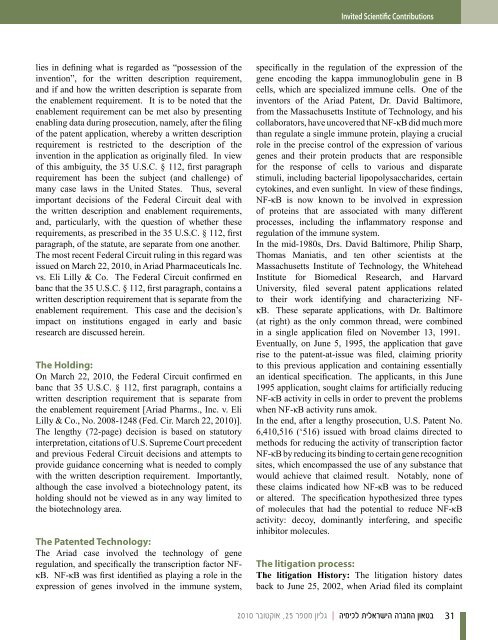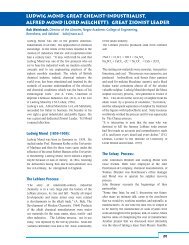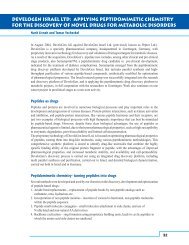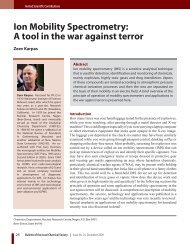CHEMISTRY IN ISRAEL - Israel Chemical Society
CHEMISTRY IN ISRAEL - Israel Chemical Society
CHEMISTRY IN ISRAEL - Israel Chemical Society
You also want an ePaper? Increase the reach of your titles
YUMPU automatically turns print PDFs into web optimized ePapers that Google loves.
lies in defining what is regarded as “possession of the<br />
invention”, for the written description requirement,<br />
and if and how the written description is separate from<br />
the enablement requirement. It is to be noted that the<br />
enablement requirement can be met also by presenting<br />
enabling data during prosecution, namely, after the filing<br />
of the patent application, whereby a written description<br />
requirement is restricted to the description of the<br />
invention in the application as originally filed. In view<br />
of this ambiguity, the 35 U.S.C. § 112, first paragraph<br />
requirement has been the subject (and challenge) of<br />
many case laws in the United States. Thus, several<br />
important decisions of the Federal Circuit deal with<br />
the written description and enablement requirements,<br />
and, particularly, with the question of whether these<br />
requirements, as prescribed in the 35 U.S.C. § 112, first<br />
paragraph, of the statute, are separate from one another.<br />
The most recent Federal Circuit ruling in this regard was<br />
issued on March 22, 2010, in Ariad Pharmaceuticals Inc.<br />
vs. Eli Lilly & Co. The Federal Circuit confirmed en<br />
banc that the 35 U.S.C. § 112, first paragraph, contains a<br />
written description requirement that is separate from the<br />
enablement requirement. This case and the decision’s<br />
impact on institutions engaged in early and basic<br />
research are discussed herein.<br />
The Holding:<br />
On March 22, 2010, the Federal Circuit confirmed en<br />
banc that 35 U.S.C. § 112, first paragraph, contains a<br />
written description requirement that is separate from<br />
the enablement requirement [Ariad Pharms., Inc. v. Eli<br />
Lilly & Co., No. 2008-1248 (Fed. Cir. March 22, 2010)].<br />
The lengthy (72-page) decision is based on statutory<br />
interpretation, citations of U.S. Supreme Court precedent<br />
and previous Federal Circuit decisions and attempts to<br />
provide guidance concerning what is needed to comply<br />
with the written description requirement. Importantly,<br />
although the case involved a biotechnology patent, its<br />
holding should not be viewed as in any way limited to<br />
the biotechnology area.<br />
The Patented Technology:<br />
The Ariad case involved the technology of gene<br />
regulation, and specifically the transcription factor NFκB.<br />
NF-κB was first identified as playing a role in the<br />
expression of genes involved in the immune system,<br />
Invited Scientific Contributions<br />
specifically in the regulation of the expression of the<br />
gene encoding the kappa immunoglobulin gene in B<br />
cells, which are specialized immune cells. One of the<br />
inventors of the Ariad Patent, Dr. David Baltimore,<br />
from the Massachusetts Institute of Technology, and his<br />
collaborators, have uncovered that NF-κB did much more<br />
than regulate a single immune protein, playing a crucial<br />
role in the precise control of the expression of various<br />
genes and their protein products that are responsible<br />
for the response of cells to various and disparate<br />
stimuli, including bacterial lipopolysaccharides, certain<br />
cytokines, and even sunlight. In view of these findings,<br />
NF-κB is now known to be involved in expression<br />
of proteins that are associated with many different<br />
processes, including the inflammatory response and<br />
regulation of the immune system.<br />
In the mid-1980s, Drs. David Baltimore, Philip Sharp,<br />
Thomas Maniatis, and ten other scientists at the<br />
Massachusetts Institute of Technology, the Whitehead<br />
Institute for Biomedical Research, and Harvard<br />
University, filed several patent applications related<br />
to their work identifying and characterizing NFκB.<br />
These separate applications, with Dr. Baltimore<br />
(at right) as the only common thread, were combined<br />
in a single application filed on November 13, 1991.<br />
Eventually, on June 5, 1995, the application that gave<br />
rise to the patent-at-issue was filed, claiming priority<br />
to this previous application and containing essentially<br />
an identical specification. The applicants, in this June<br />
1995 application, sought claims for artificially reducing<br />
NF-κB activity in cells in order to prevent the problems<br />
when NF-κB activity runs amok.<br />
In the end, after a lengthy prosecution, U.S. Patent No.<br />
6,410,516 (‘516) issued with broad claims directed to<br />
methods for reducing the activity of transcription factor<br />
NF-κB by reducing its binding to certain gene recognition<br />
sites, which encompassed the use of any substance that<br />
would achieve that claimed result. Notably, none of<br />
these claims indicated how NF-κB was to be reduced<br />
or altered. The specification hypothesized three types<br />
of molecules that had the potential to reduce NF-κB<br />
activity: decoy, dominantly interfering, and specific<br />
inhibitor molecules.<br />
The litigation process:<br />
The litigation History: The litigation history dates<br />
back to June 25, 2002, when Ariad filed its complaint<br />
2010 רבוטקוא ,25 רפסמ ןוילג | הימיכל תילארשיה הרבחה ןואטב<br />
31






